Accountability in Nursing Practice: Case Study and Analysis
VerifiedAdded on 2023/01/17
|12
|3086
|33
AI Summary
This article examines a case study on accountability in nursing practice, focusing on a specific incident that led to adverse patient outcomes. It discusses the actions and omissions that contributed to the adverse outcome, the factors involved, and the policies and standards of practice that were breached. The article also explores the actions that could have prevented the adverse outcome.
Contribute Materials
Your contribution can guide someone’s learning journey. Share your
documents today.
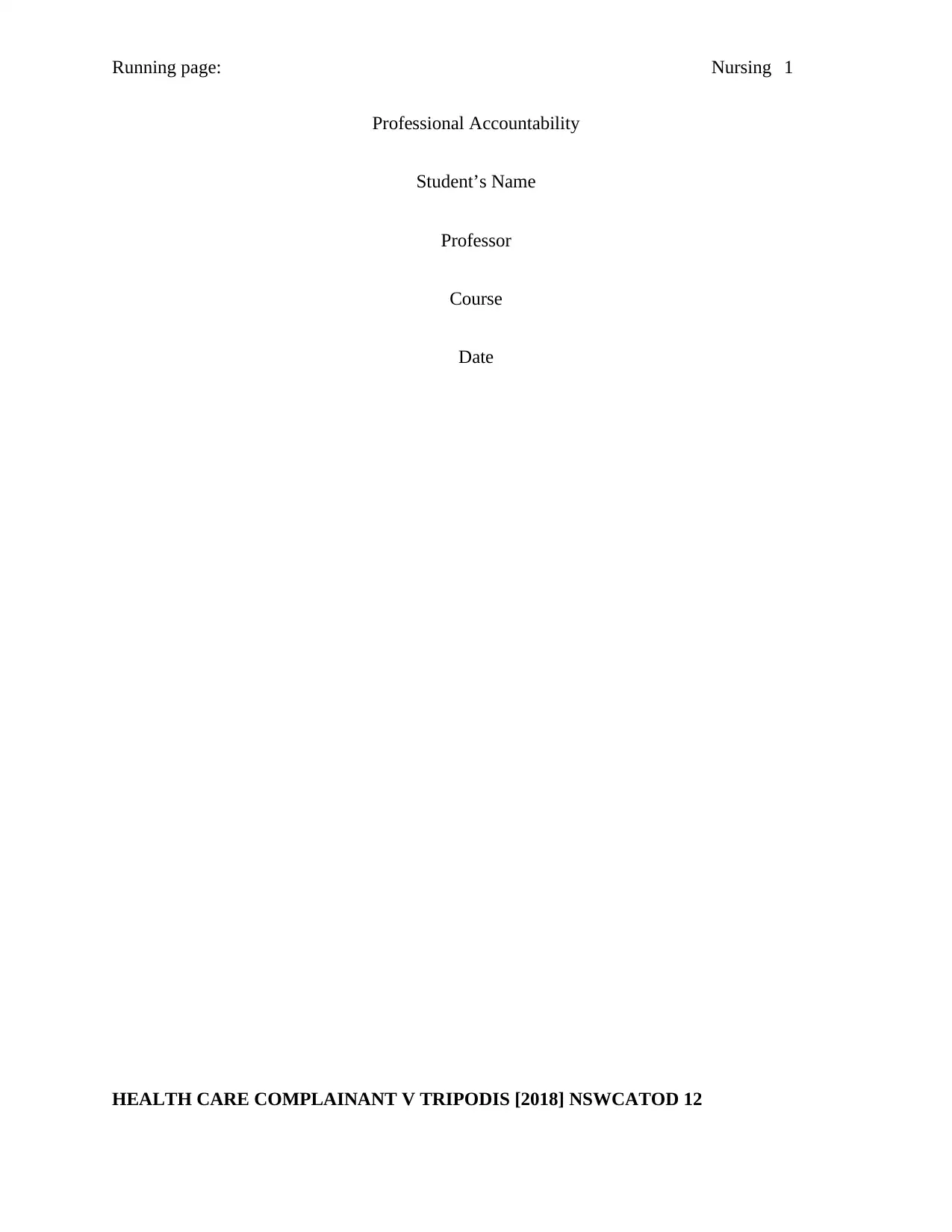
Running page: Nursing 1
Professional Accountability
Student’s Name
Professor
Course
Date
HEALTH CARE COMPLAINANT V TRIPODIS [2018] NSWCATOD 12
Professional Accountability
Student’s Name
Professor
Course
Date
HEALTH CARE COMPLAINANT V TRIPODIS [2018] NSWCATOD 12
Secure Best Marks with AI Grader
Need help grading? Try our AI Grader for instant feedback on your assignments.
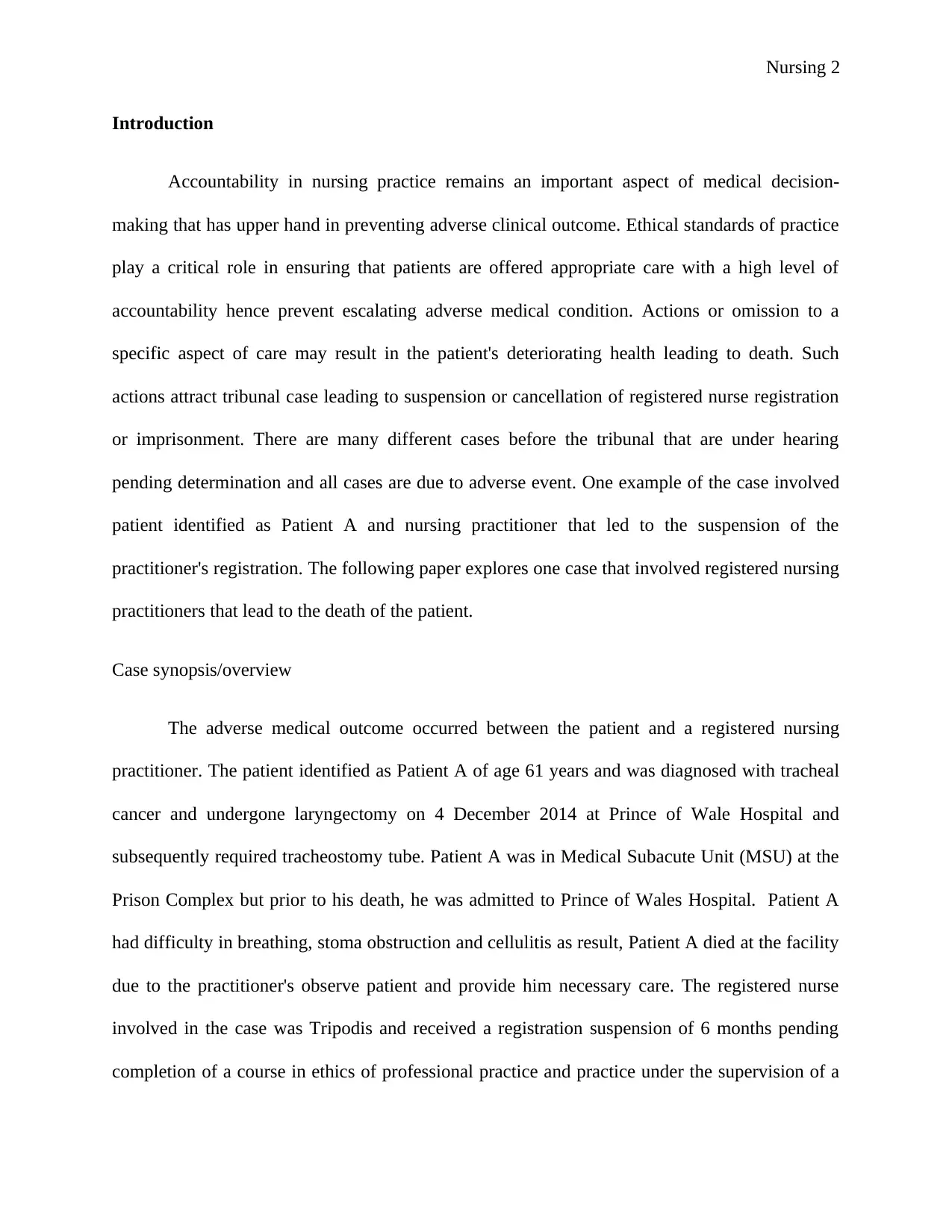
Nursing 2
Introduction
Accountability in nursing practice remains an important aspect of medical decision-
making that has upper hand in preventing adverse clinical outcome. Ethical standards of practice
play a critical role in ensuring that patients are offered appropriate care with a high level of
accountability hence prevent escalating adverse medical condition. Actions or omission to a
specific aspect of care may result in the patient's deteriorating health leading to death. Such
actions attract tribunal case leading to suspension or cancellation of registered nurse registration
or imprisonment. There are many different cases before the tribunal that are under hearing
pending determination and all cases are due to adverse event. One example of the case involved
patient identified as Patient A and nursing practitioner that led to the suspension of the
practitioner's registration. The following paper explores one case that involved registered nursing
practitioners that lead to the death of the patient.
Case synopsis/overview
The adverse medical outcome occurred between the patient and a registered nursing
practitioner. The patient identified as Patient A of age 61 years and was diagnosed with tracheal
cancer and undergone laryngectomy on 4 December 2014 at Prince of Wale Hospital and
subsequently required tracheostomy tube. Patient A was in Medical Subacute Unit (MSU) at the
Prison Complex but prior to his death, he was admitted to Prince of Wales Hospital. Patient A
had difficulty in breathing, stoma obstruction and cellulitis as result, Patient A died at the facility
due to the practitioner's observe patient and provide him necessary care. The registered nurse
involved in the case was Tripodis and received a registration suspension of 6 months pending
completion of a course in ethics of professional practice and practice under the supervision of a
Introduction
Accountability in nursing practice remains an important aspect of medical decision-
making that has upper hand in preventing adverse clinical outcome. Ethical standards of practice
play a critical role in ensuring that patients are offered appropriate care with a high level of
accountability hence prevent escalating adverse medical condition. Actions or omission to a
specific aspect of care may result in the patient's deteriorating health leading to death. Such
actions attract tribunal case leading to suspension or cancellation of registered nurse registration
or imprisonment. There are many different cases before the tribunal that are under hearing
pending determination and all cases are due to adverse event. One example of the case involved
patient identified as Patient A and nursing practitioner that led to the suspension of the
practitioner's registration. The following paper explores one case that involved registered nursing
practitioners that lead to the death of the patient.
Case synopsis/overview
The adverse medical outcome occurred between the patient and a registered nursing
practitioner. The patient identified as Patient A of age 61 years and was diagnosed with tracheal
cancer and undergone laryngectomy on 4 December 2014 at Prince of Wale Hospital and
subsequently required tracheostomy tube. Patient A was in Medical Subacute Unit (MSU) at the
Prison Complex but prior to his death, he was admitted to Prince of Wales Hospital. Patient A
had difficulty in breathing, stoma obstruction and cellulitis as result, Patient A died at the facility
due to the practitioner's observe patient and provide him necessary care. The registered nurse
involved in the case was Tripodis and received a registration suspension of 6 months pending
completion of a course in ethics of professional practice and practice under the supervision of a

Nursing 3
registered nurse (Division 1) (Civil and Administrative Tribunal New South Wales
(NSWCATOD) 2018).
Actions/Omission Contributed to Adverse Outcome
Actions
There are some actions of the practitioners that contributed to the adverse medical
outcome of Patient A. Tripodis gave Patent A nebulizers to use at night when she was on night
shift. The registered nurse administered the nebulized saline to the patient but only noted the
medication without the reason for administering the medication to the patient. According to the
prescription of PRN, giving the patient any medication needs proper documentation which was
not the case. In addition, the practitioners also administered diazepam as a regular medication to
Patient A. According to the case, the practitioner recorded limited information on the medication
given to the patient contrary to the normal procedure of patient health records (Kalisch & Boqin
2014). Another action of the practitioner that was no consistent with the standard of practice was
advising the patient to knock up whenever he needed assistance from nursing practitioner. This
was not appropriate given the speech impairment of the patient that could not allow the patient to
communicate with anyone. The practitioner visited patient late than necessary since the
practitioner was supposed to attend to Patient A 12:00 am and 4:00 am but instead attended to
the patient at 6:30 am after being notified by the Corrective Service Officer. This was a
substandard practice expected of a registered nursing practitioner especially on night shift
(Halpern et al., 2011).
Omission
registered nurse (Division 1) (Civil and Administrative Tribunal New South Wales
(NSWCATOD) 2018).
Actions/Omission Contributed to Adverse Outcome
Actions
There are some actions of the practitioners that contributed to the adverse medical
outcome of Patient A. Tripodis gave Patent A nebulizers to use at night when she was on night
shift. The registered nurse administered the nebulized saline to the patient but only noted the
medication without the reason for administering the medication to the patient. According to the
prescription of PRN, giving the patient any medication needs proper documentation which was
not the case. In addition, the practitioners also administered diazepam as a regular medication to
Patient A. According to the case, the practitioner recorded limited information on the medication
given to the patient contrary to the normal procedure of patient health records (Kalisch & Boqin
2014). Another action of the practitioner that was no consistent with the standard of practice was
advising the patient to knock up whenever he needed assistance from nursing practitioner. This
was not appropriate given the speech impairment of the patient that could not allow the patient to
communicate with anyone. The practitioner visited patient late than necessary since the
practitioner was supposed to attend to Patient A 12:00 am and 4:00 am but instead attended to
the patient at 6:30 am after being notified by the Corrective Service Officer. This was a
substandard practice expected of a registered nursing practitioner especially on night shift
(Halpern et al., 2011).
Omission
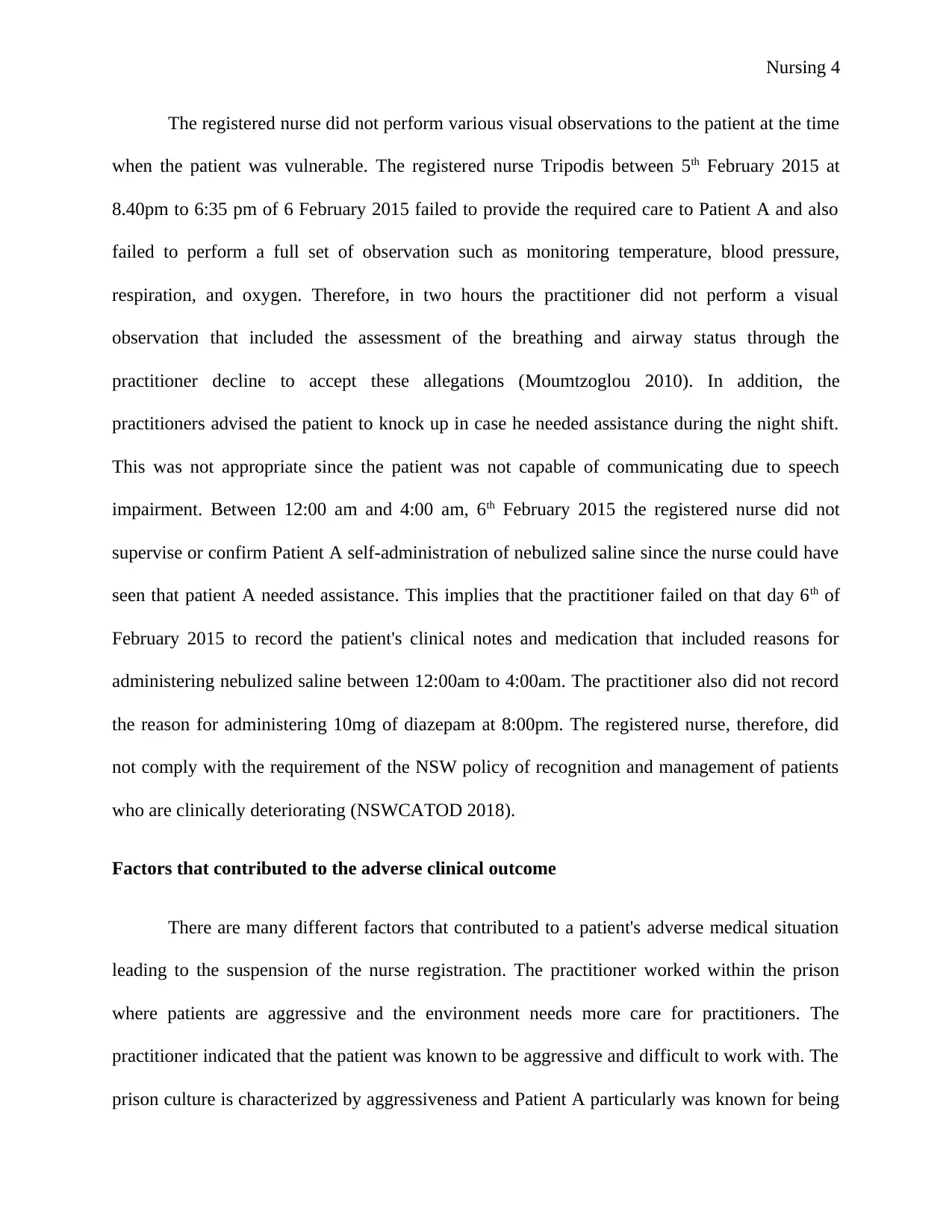
Nursing 4
The registered nurse did not perform various visual observations to the patient at the time
when the patient was vulnerable. The registered nurse Tripodis between 5th February 2015 at
8.40pm to 6:35 pm of 6 February 2015 failed to provide the required care to Patient A and also
failed to perform a full set of observation such as monitoring temperature, blood pressure,
respiration, and oxygen. Therefore, in two hours the practitioner did not perform a visual
observation that included the assessment of the breathing and airway status through the
practitioner decline to accept these allegations (Moumtzoglou 2010). In addition, the
practitioners advised the patient to knock up in case he needed assistance during the night shift.
This was not appropriate since the patient was not capable of communicating due to speech
impairment. Between 12:00 am and 4:00 am, 6th February 2015 the registered nurse did not
supervise or confirm Patient A self-administration of nebulized saline since the nurse could have
seen that patient A needed assistance. This implies that the practitioner failed on that day 6th of
February 2015 to record the patient's clinical notes and medication that included reasons for
administering nebulized saline between 12:00am to 4:00am. The practitioner also did not record
the reason for administering 10mg of diazepam at 8:00pm. The registered nurse, therefore, did
not comply with the requirement of the NSW policy of recognition and management of patients
who are clinically deteriorating (NSWCATOD 2018).
Factors that contributed to the adverse clinical outcome
There are many different factors that contributed to a patient's adverse medical situation
leading to the suspension of the nurse registration. The practitioner worked within the prison
where patients are aggressive and the environment needs more care for practitioners. The
practitioner indicated that the patient was known to be aggressive and difficult to work with. The
prison culture is characterized by aggressiveness and Patient A particularly was known for being
The registered nurse did not perform various visual observations to the patient at the time
when the patient was vulnerable. The registered nurse Tripodis between 5th February 2015 at
8.40pm to 6:35 pm of 6 February 2015 failed to provide the required care to Patient A and also
failed to perform a full set of observation such as monitoring temperature, blood pressure,
respiration, and oxygen. Therefore, in two hours the practitioner did not perform a visual
observation that included the assessment of the breathing and airway status through the
practitioner decline to accept these allegations (Moumtzoglou 2010). In addition, the
practitioners advised the patient to knock up in case he needed assistance during the night shift.
This was not appropriate since the patient was not capable of communicating due to speech
impairment. Between 12:00 am and 4:00 am, 6th February 2015 the registered nurse did not
supervise or confirm Patient A self-administration of nebulized saline since the nurse could have
seen that patient A needed assistance. This implies that the practitioner failed on that day 6th of
February 2015 to record the patient's clinical notes and medication that included reasons for
administering nebulized saline between 12:00am to 4:00am. The practitioner also did not record
the reason for administering 10mg of diazepam at 8:00pm. The registered nurse, therefore, did
not comply with the requirement of the NSW policy of recognition and management of patients
who are clinically deteriorating (NSWCATOD 2018).
Factors that contributed to the adverse clinical outcome
There are many different factors that contributed to a patient's adverse medical situation
leading to the suspension of the nurse registration. The practitioner worked within the prison
where patients are aggressive and the environment needs more care for practitioners. The
practitioner indicated that the patient was known to be aggressive and difficult to work with. The
prison culture is characterized by aggressiveness and Patient A particularly was known for being
Secure Best Marks with AI Grader
Need help grading? Try our AI Grader for instant feedback on your assignments.
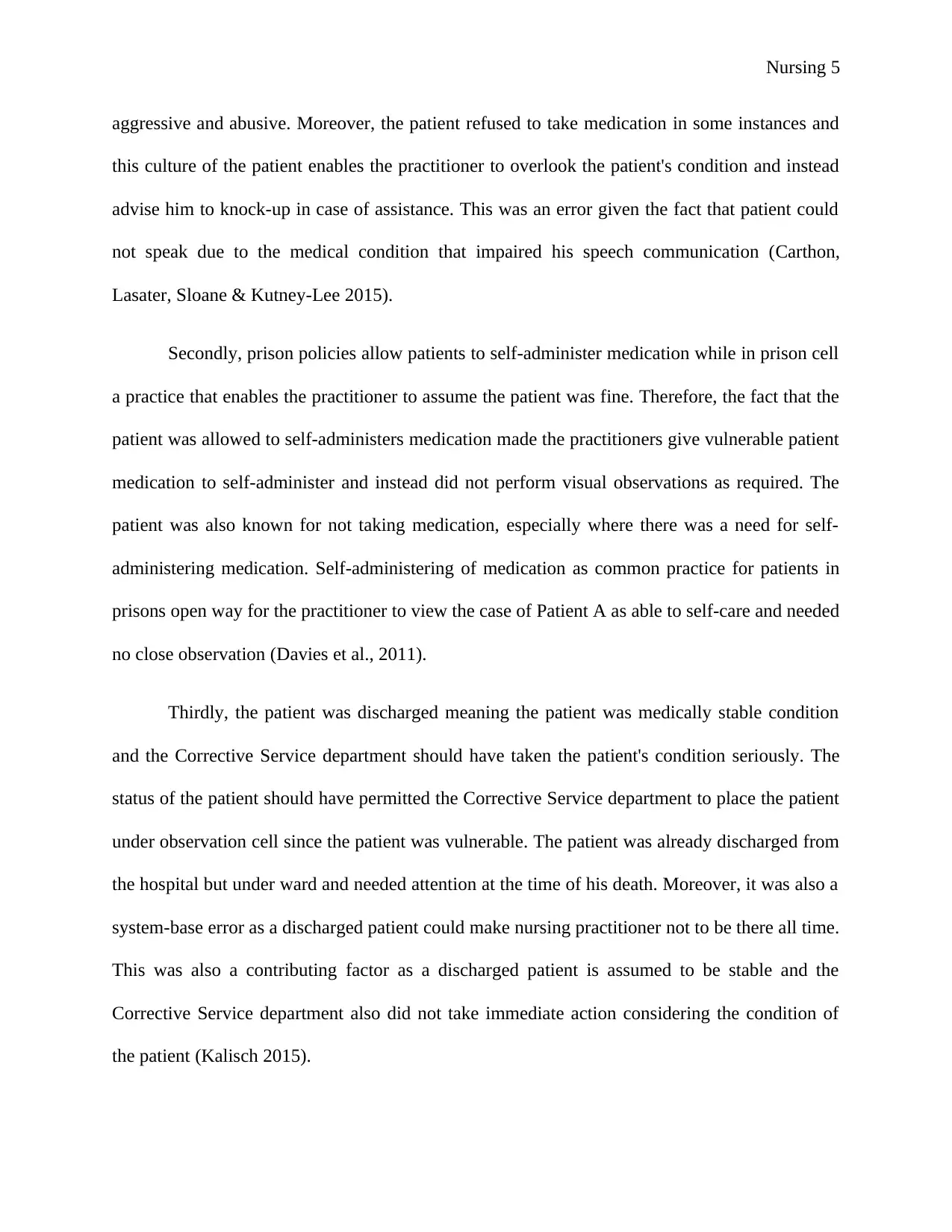
Nursing 5
aggressive and abusive. Moreover, the patient refused to take medication in some instances and
this culture of the patient enables the practitioner to overlook the patient's condition and instead
advise him to knock-up in case of assistance. This was an error given the fact that patient could
not speak due to the medical condition that impaired his speech communication (Carthon,
Lasater, Sloane & Kutney-Lee 2015).
Secondly, prison policies allow patients to self-administer medication while in prison cell
a practice that enables the practitioner to assume the patient was fine. Therefore, the fact that the
patient was allowed to self-administers medication made the practitioners give vulnerable patient
medication to self-administer and instead did not perform visual observations as required. The
patient was also known for not taking medication, especially where there was a need for self-
administering medication. Self-administering of medication as common practice for patients in
prisons open way for the practitioner to view the case of Patient A as able to self-care and needed
no close observation (Davies et al., 2011).
Thirdly, the patient was discharged meaning the patient was medically stable condition
and the Corrective Service department should have taken the patient's condition seriously. The
status of the patient should have permitted the Corrective Service department to place the patient
under observation cell since the patient was vulnerable. The patient was already discharged from
the hospital but under ward and needed attention at the time of his death. Moreover, it was also a
system-base error as a discharged patient could make nursing practitioner not to be there all time.
This was also a contributing factor as a discharged patient is assumed to be stable and the
Corrective Service department also did not take immediate action considering the condition of
the patient (Kalisch 2015).
aggressive and abusive. Moreover, the patient refused to take medication in some instances and
this culture of the patient enables the practitioner to overlook the patient's condition and instead
advise him to knock-up in case of assistance. This was an error given the fact that patient could
not speak due to the medical condition that impaired his speech communication (Carthon,
Lasater, Sloane & Kutney-Lee 2015).
Secondly, prison policies allow patients to self-administer medication while in prison cell
a practice that enables the practitioner to assume the patient was fine. Therefore, the fact that the
patient was allowed to self-administers medication made the practitioners give vulnerable patient
medication to self-administer and instead did not perform visual observations as required. The
patient was also known for not taking medication, especially where there was a need for self-
administering medication. Self-administering of medication as common practice for patients in
prisons open way for the practitioner to view the case of Patient A as able to self-care and needed
no close observation (Davies et al., 2011).
Thirdly, the patient was discharged meaning the patient was medically stable condition
and the Corrective Service department should have taken the patient's condition seriously. The
status of the patient should have permitted the Corrective Service department to place the patient
under observation cell since the patient was vulnerable. The patient was already discharged from
the hospital but under ward and needed attention at the time of his death. Moreover, it was also a
system-base error as a discharged patient could make nursing practitioner not to be there all time.
This was also a contributing factor as a discharged patient is assumed to be stable and the
Corrective Service department also did not take immediate action considering the condition of
the patient (Kalisch 2015).
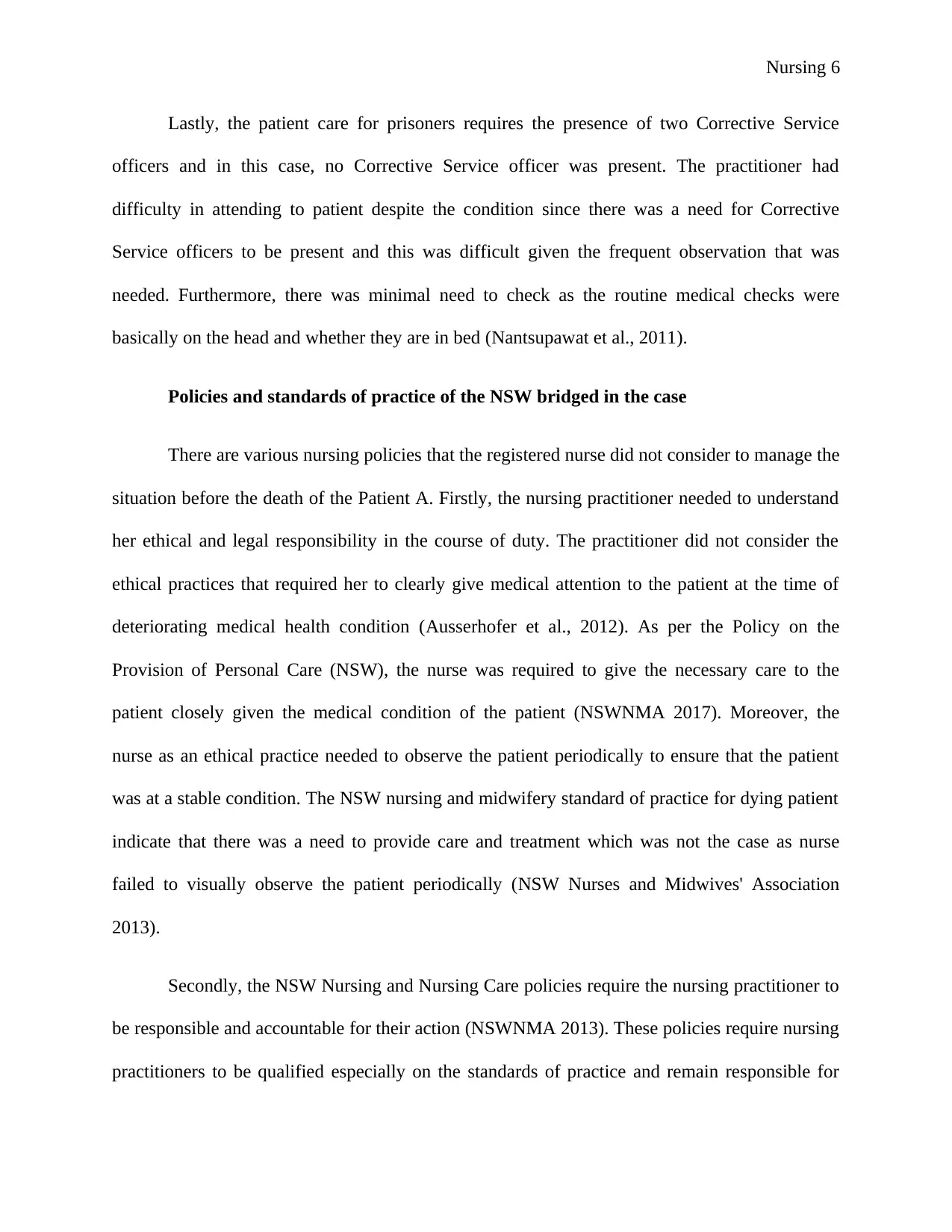
Nursing 6
Lastly, the patient care for prisoners requires the presence of two Corrective Service
officers and in this case, no Corrective Service officer was present. The practitioner had
difficulty in attending to patient despite the condition since there was a need for Corrective
Service officers to be present and this was difficult given the frequent observation that was
needed. Furthermore, there was minimal need to check as the routine medical checks were
basically on the head and whether they are in bed (Nantsupawat et al., 2011).
Policies and standards of practice of the NSW bridged in the case
There are various nursing policies that the registered nurse did not consider to manage the
situation before the death of the Patient A. Firstly, the nursing practitioner needed to understand
her ethical and legal responsibility in the course of duty. The practitioner did not consider the
ethical practices that required her to clearly give medical attention to the patient at the time of
deteriorating medical health condition (Ausserhofer et al., 2012). As per the Policy on the
Provision of Personal Care (NSW), the nurse was required to give the necessary care to the
patient closely given the medical condition of the patient (NSWNMA 2017). Moreover, the
nurse as an ethical practice needed to observe the patient periodically to ensure that the patient
was at a stable condition. The NSW nursing and midwifery standard of practice for dying patient
indicate that there was a need to provide care and treatment which was not the case as nurse
failed to visually observe the patient periodically (NSW Nurses and Midwives' Association
2013).
Secondly, the NSW Nursing and Nursing Care policies require the nursing practitioner to
be responsible and accountable for their action (NSWNMA 2013). These policies require nursing
practitioners to be qualified especially on the standards of practice and remain responsible for
Lastly, the patient care for prisoners requires the presence of two Corrective Service
officers and in this case, no Corrective Service officer was present. The practitioner had
difficulty in attending to patient despite the condition since there was a need for Corrective
Service officers to be present and this was difficult given the frequent observation that was
needed. Furthermore, there was minimal need to check as the routine medical checks were
basically on the head and whether they are in bed (Nantsupawat et al., 2011).
Policies and standards of practice of the NSW bridged in the case
There are various nursing policies that the registered nurse did not consider to manage the
situation before the death of the Patient A. Firstly, the nursing practitioner needed to understand
her ethical and legal responsibility in the course of duty. The practitioner did not consider the
ethical practices that required her to clearly give medical attention to the patient at the time of
deteriorating medical health condition (Ausserhofer et al., 2012). As per the Policy on the
Provision of Personal Care (NSW), the nurse was required to give the necessary care to the
patient closely given the medical condition of the patient (NSWNMA 2017). Moreover, the
nurse as an ethical practice needed to observe the patient periodically to ensure that the patient
was at a stable condition. The NSW nursing and midwifery standard of practice for dying patient
indicate that there was a need to provide care and treatment which was not the case as nurse
failed to visually observe the patient periodically (NSW Nurses and Midwives' Association
2013).
Secondly, the NSW Nursing and Nursing Care policies require the nursing practitioner to
be responsible and accountable for their action (NSWNMA 2013). These policies require nursing
practitioners to be qualified especially on the standards of practice and remain responsible for

Nursing 7
their action. For instance, the Medical Practice Act 1992 (NSW) Part 4 provides the qualification
of a medical practitioner to be registered and unprofessional conduct against the practitioner.
This was not the case the nursing practitioner failed to provide the required care to patient
leading to the death of the patient (Weiss & Elixhauser 2013). In addition, the nursing
practitioner was also required to administer treatment that was consistent with the standard of
practice outlined in the nursing care standard of practice and codes. The level of accountability
of the nursing practitioner should be consistent with the education, environment, and standards
of practice guiding the medical practitioners. Action as professional would have ensured that the
patient's condition does not escalate to the point of death and immediate emergency services
would have been provided to the patient (Holvey, Connolly & Taylor 2010).
Nursing practitioners are required to provide non-discriminatory care to patient
irrespective of their cultural behavior or previous medical history. The nursing care, to the
patient, remains universal and should be given to any patient without any discrimination despite
their behavior or culture (Christiaans-Dingelhoff et al., 2011). This was not the case as the
practitioner had considered the aggressiveness of the patient and his medical history of not taking
medication. In addition, nursing practitioners also considered the working environment as a way
to overlook the medical condition of the patient as critical. This was against the policies and
standards of practice leading to the death of the patient. Suppose the practitioner would have
acted in a more professional way to consider the vulnerability of the patient the nursing
practitioner would have administered medication to patient conducted the necessary care and
observation as required of registered nurse (Carthon et al., 2019).
Quality use of Medicine is another policy that shows the conduct of registered nurse
when administering medication to patients (NSWNMA 2017). The policy required nursing
their action. For instance, the Medical Practice Act 1992 (NSW) Part 4 provides the qualification
of a medical practitioner to be registered and unprofessional conduct against the practitioner.
This was not the case the nursing practitioner failed to provide the required care to patient
leading to the death of the patient (Weiss & Elixhauser 2013). In addition, the nursing
practitioner was also required to administer treatment that was consistent with the standard of
practice outlined in the nursing care standard of practice and codes. The level of accountability
of the nursing practitioner should be consistent with the education, environment, and standards
of practice guiding the medical practitioners. Action as professional would have ensured that the
patient's condition does not escalate to the point of death and immediate emergency services
would have been provided to the patient (Holvey, Connolly & Taylor 2010).
Nursing practitioners are required to provide non-discriminatory care to patient
irrespective of their cultural behavior or previous medical history. The nursing care, to the
patient, remains universal and should be given to any patient without any discrimination despite
their behavior or culture (Christiaans-Dingelhoff et al., 2011). This was not the case as the
practitioner had considered the aggressiveness of the patient and his medical history of not taking
medication. In addition, nursing practitioners also considered the working environment as a way
to overlook the medical condition of the patient as critical. This was against the policies and
standards of practice leading to the death of the patient. Suppose the practitioner would have
acted in a more professional way to consider the vulnerability of the patient the nursing
practitioner would have administered medication to patient conducted the necessary care and
observation as required of registered nurse (Carthon et al., 2019).
Quality use of Medicine is another policy that shows the conduct of registered nurse
when administering medication to patients (NSWNMA 2017). The policy required nursing
Paraphrase This Document
Need a fresh take? Get an instant paraphrase of this document with our AI Paraphraser
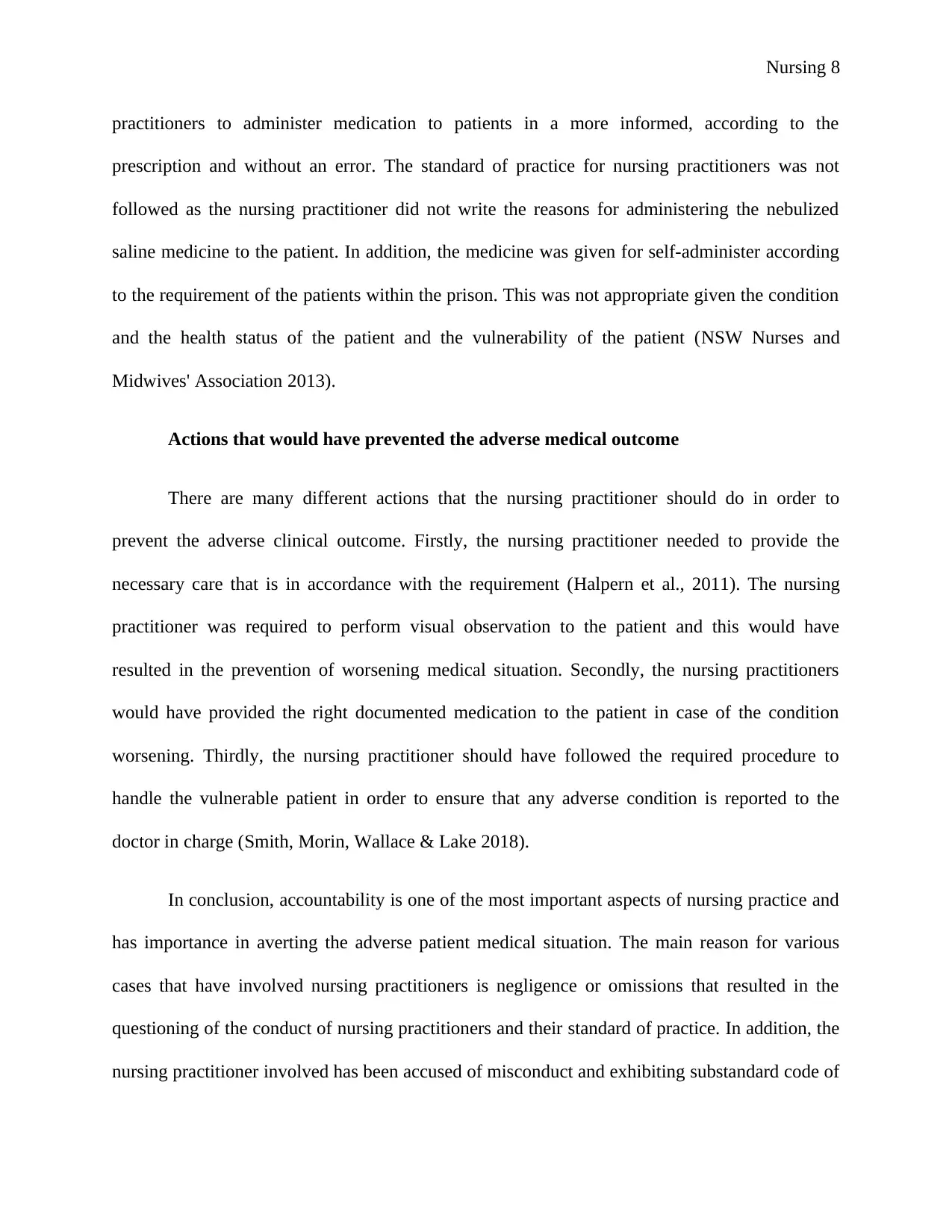
Nursing 8
practitioners to administer medication to patients in a more informed, according to the
prescription and without an error. The standard of practice for nursing practitioners was not
followed as the nursing practitioner did not write the reasons for administering the nebulized
saline medicine to the patient. In addition, the medicine was given for self-administer according
to the requirement of the patients within the prison. This was not appropriate given the condition
and the health status of the patient and the vulnerability of the patient (NSW Nurses and
Midwives' Association 2013).
Actions that would have prevented the adverse medical outcome
There are many different actions that the nursing practitioner should do in order to
prevent the adverse clinical outcome. Firstly, the nursing practitioner needed to provide the
necessary care that is in accordance with the requirement (Halpern et al., 2011). The nursing
practitioner was required to perform visual observation to the patient and this would have
resulted in the prevention of worsening medical situation. Secondly, the nursing practitioners
would have provided the right documented medication to the patient in case of the condition
worsening. Thirdly, the nursing practitioner should have followed the required procedure to
handle the vulnerable patient in order to ensure that any adverse condition is reported to the
doctor in charge (Smith, Morin, Wallace & Lake 2018).
In conclusion, accountability is one of the most important aspects of nursing practice and
has importance in averting the adverse patient medical situation. The main reason for various
cases that have involved nursing practitioners is negligence or omissions that resulted in the
questioning of the conduct of nursing practitioners and their standard of practice. In addition, the
nursing practitioner involved has been accused of misconduct and exhibiting substandard code of
practitioners to administer medication to patients in a more informed, according to the
prescription and without an error. The standard of practice for nursing practitioners was not
followed as the nursing practitioner did not write the reasons for administering the nebulized
saline medicine to the patient. In addition, the medicine was given for self-administer according
to the requirement of the patients within the prison. This was not appropriate given the condition
and the health status of the patient and the vulnerability of the patient (NSW Nurses and
Midwives' Association 2013).
Actions that would have prevented the adverse medical outcome
There are many different actions that the nursing practitioner should do in order to
prevent the adverse clinical outcome. Firstly, the nursing practitioner needed to provide the
necessary care that is in accordance with the requirement (Halpern et al., 2011). The nursing
practitioner was required to perform visual observation to the patient and this would have
resulted in the prevention of worsening medical situation. Secondly, the nursing practitioners
would have provided the right documented medication to the patient in case of the condition
worsening. Thirdly, the nursing practitioner should have followed the required procedure to
handle the vulnerable patient in order to ensure that any adverse condition is reported to the
doctor in charge (Smith, Morin, Wallace & Lake 2018).
In conclusion, accountability is one of the most important aspects of nursing practice and
has importance in averting the adverse patient medical situation. The main reason for various
cases that have involved nursing practitioners is negligence or omissions that resulted in the
questioning of the conduct of nursing practitioners and their standard of practice. In addition, the
nursing practitioner involved has been accused of misconduct and exhibiting substandard code of
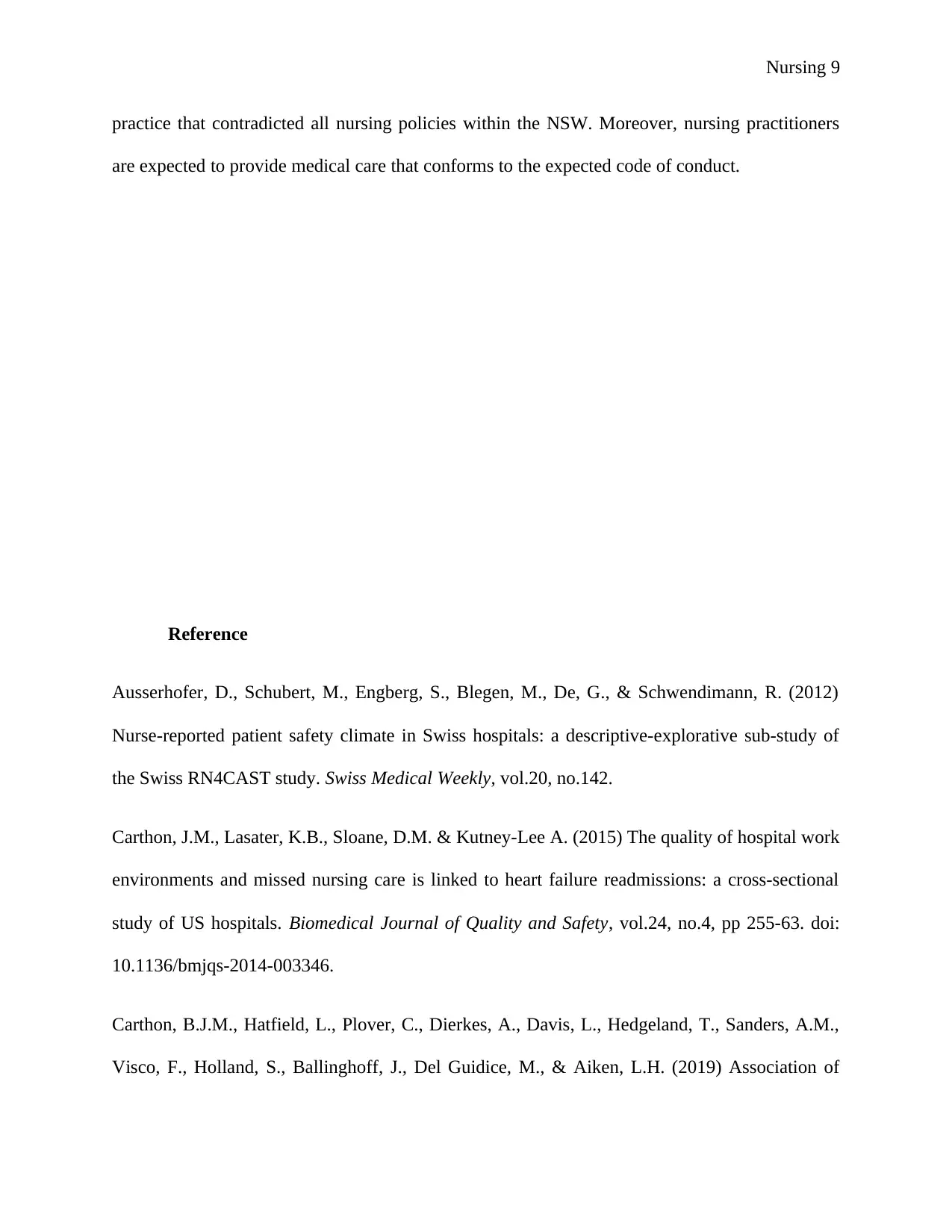
Nursing 9
practice that contradicted all nursing policies within the NSW. Moreover, nursing practitioners
are expected to provide medical care that conforms to the expected code of conduct.
Reference
Ausserhofer, D., Schubert, M., Engberg, S., Blegen, M., De, G., & Schwendimann, R. (2012)
Nurse-reported patient safety climate in Swiss hospitals: a descriptive-explorative sub-study of
the Swiss RN4CAST study. Swiss Medical Weekly, vol.20, no.142.
Carthon, J.M., Lasater, K.B., Sloane, D.M. & Kutney-Lee A. (2015) The quality of hospital work
environments and missed nursing care is linked to heart failure readmissions: a cross-sectional
study of US hospitals. Biomedical Journal of Quality and Safety, vol.24, no.4, pp 255-63. doi:
10.1136/bmjqs-2014-003346.
Carthon, B.J.M., Hatfield, L., Plover, C., Dierkes, A., Davis, L., Hedgeland, T., Sanders, A.M.,
Visco, F., Holland, S., Ballinghoff, J., Del Guidice, M., & Aiken, L.H. (2019) Association of
practice that contradicted all nursing policies within the NSW. Moreover, nursing practitioners
are expected to provide medical care that conforms to the expected code of conduct.
Reference
Ausserhofer, D., Schubert, M., Engberg, S., Blegen, M., De, G., & Schwendimann, R. (2012)
Nurse-reported patient safety climate in Swiss hospitals: a descriptive-explorative sub-study of
the Swiss RN4CAST study. Swiss Medical Weekly, vol.20, no.142.
Carthon, J.M., Lasater, K.B., Sloane, D.M. & Kutney-Lee A. (2015) The quality of hospital work
environments and missed nursing care is linked to heart failure readmissions: a cross-sectional
study of US hospitals. Biomedical Journal of Quality and Safety, vol.24, no.4, pp 255-63. doi:
10.1136/bmjqs-2014-003346.
Carthon, B.J.M., Hatfield, L., Plover, C., Dierkes, A., Davis, L., Hedgeland, T., Sanders, A.M.,
Visco, F., Holland, S., Ballinghoff, J., Del Guidice, M., & Aiken, L.H. (2019) Association of

Nursing 10
Nurse Engagement and Nurse Staffing on Patient Safety. Journal of Nursing Care Quality,
vol.34, no.1, pp 40-46. doi: 10.1097/NCQ.0000000000000334.
Christiaans-Dingelhoff, I., Smits, M., Zwaan, L., Lubberding, S., van der Wal, G., & Wagner, C.
(2011) To what extent are adverse events found in patient records reported by patients and
healthcare professionals via complaints, claims, and incident reports? BMC Health Service
Research, vol.11, no.49, pp 49–49.
Civil and Administrative Tribunal New South Wales (NSWCATOD) (2018) Health Care
Complaints Commission v Tripodis [2018] NSWCATOD 12. Available at
https://www.caselaw.nsw.gov.au/decision/5a695a5de4b058596cbadbe0 [accessed on 4, April 6,
2019]
Davies, E.C., Rowe, P.H., James, S., et al. (2011) An Investigation of Disagreement in Causality
Assessment of Adverse Drug Reactions. Pharmaceutical Med. Vol.25, no.1, pp 17–24.
doi:10.1007/bf03256843.
Halpern, M.T., Roussel A.E., Treiman, K., Nerz, P.A., Hatlie, M.J., & Sheridan, S. (2011)
Designing Consumer Reporting Systems for Patient Safety Events. Agency for Healthcare
Research and Quality; Rockville, MD: July. Available at
http://www.ahrq.gov/qual/consreporting/
Holvey, C., Connolly, A. & Taylor, D. (August 2010) Psychiatric side effects of non-psychiatric
drugs. British journal of hospital medicine (London, England: 2005). Vol.71, no.8, pp 432–6.
doi:10.12968/hmed.2010.71.8.77664
Nurse Engagement and Nurse Staffing on Patient Safety. Journal of Nursing Care Quality,
vol.34, no.1, pp 40-46. doi: 10.1097/NCQ.0000000000000334.
Christiaans-Dingelhoff, I., Smits, M., Zwaan, L., Lubberding, S., van der Wal, G., & Wagner, C.
(2011) To what extent are adverse events found in patient records reported by patients and
healthcare professionals via complaints, claims, and incident reports? BMC Health Service
Research, vol.11, no.49, pp 49–49.
Civil and Administrative Tribunal New South Wales (NSWCATOD) (2018) Health Care
Complaints Commission v Tripodis [2018] NSWCATOD 12. Available at
https://www.caselaw.nsw.gov.au/decision/5a695a5de4b058596cbadbe0 [accessed on 4, April 6,
2019]
Davies, E.C., Rowe, P.H., James, S., et al. (2011) An Investigation of Disagreement in Causality
Assessment of Adverse Drug Reactions. Pharmaceutical Med. Vol.25, no.1, pp 17–24.
doi:10.1007/bf03256843.
Halpern, M.T., Roussel A.E., Treiman, K., Nerz, P.A., Hatlie, M.J., & Sheridan, S. (2011)
Designing Consumer Reporting Systems for Patient Safety Events. Agency for Healthcare
Research and Quality; Rockville, MD: July. Available at
http://www.ahrq.gov/qual/consreporting/
Holvey, C., Connolly, A. & Taylor, D. (August 2010) Psychiatric side effects of non-psychiatric
drugs. British journal of hospital medicine (London, England: 2005). Vol.71, no.8, pp 432–6.
doi:10.12968/hmed.2010.71.8.77664
Secure Best Marks with AI Grader
Need help grading? Try our AI Grader for instant feedback on your assignments.
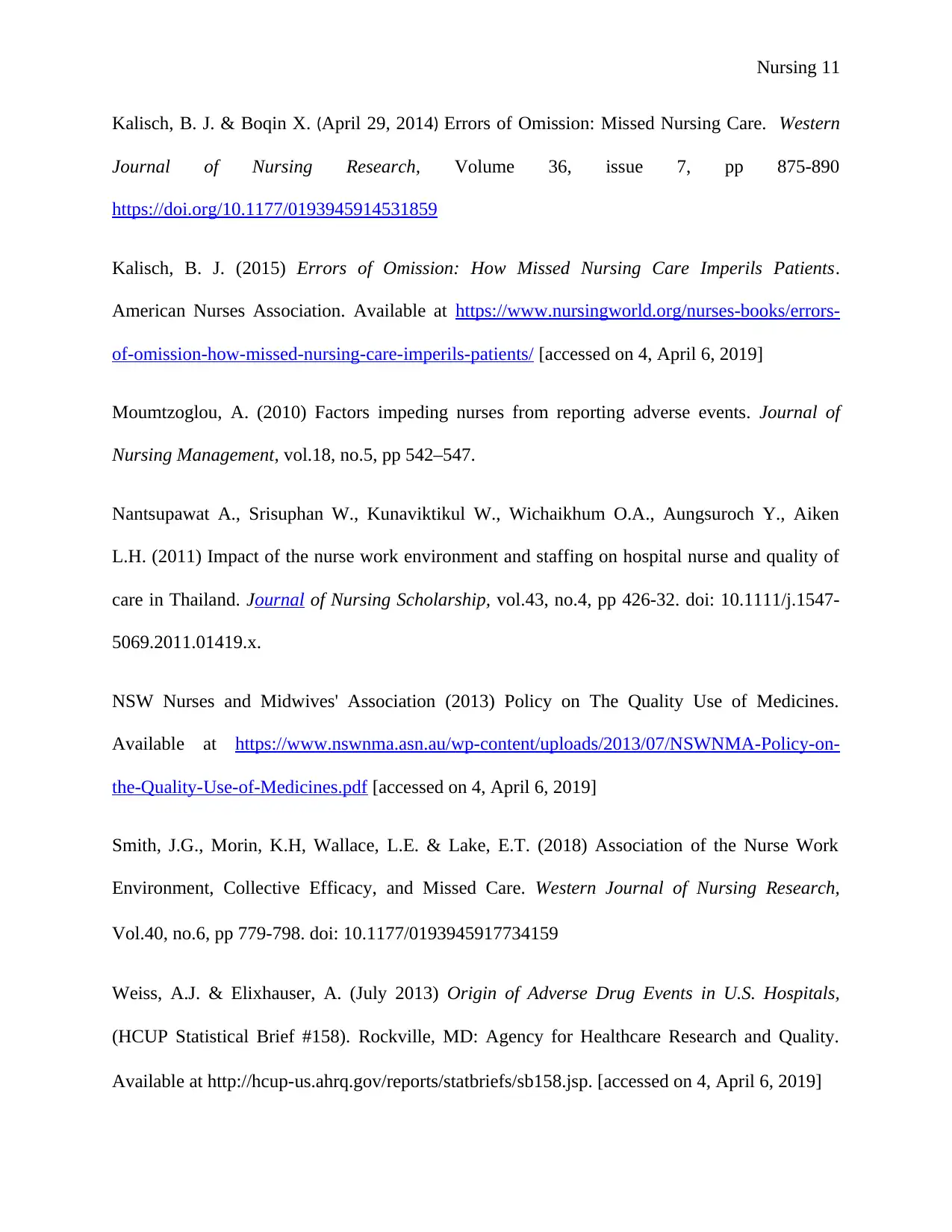
Nursing 11
Kalisch, B. J. & Boqin X. (April 29, 2014) Errors of Omission: Missed Nursing Care. Western
Journal of Nursing Research, Volume 36, issue 7, pp 875-890
https://doi.org/10.1177/0193945914531859
Kalisch, B. J. (2015) Errors of Omission: How Missed Nursing Care Imperils Patients.
American Nurses Association. Available at https://www.nursingworld.org/nurses-books/errors-
of-omission-how-missed-nursing-care-imperils-patients/ [accessed on 4, April 6, 2019]
Moumtzoglou, A. (2010) Factors impeding nurses from reporting adverse events. Journal of
Nursing Management, vol.18, no.5, pp 542–547.
Nantsupawat A., Srisuphan W., Kunaviktikul W., Wichaikhum O.A., Aungsuroch Y., Aiken
L.H. (2011) Impact of the nurse work environment and staffing on hospital nurse and quality of
care in Thailand. Journal of Nursing Scholarship, vol.43, no.4, pp 426-32. doi: 10.1111/j.1547-
5069.2011.01419.x.
NSW Nurses and Midwives' Association (2013) Policy on The Quality Use of Medicines.
Available at https://www.nswnma.asn.au/wp-content/uploads/2013/07/NSWNMA-Policy-on-
the-Quality-Use-of-Medicines.pdf [accessed on 4, April 6, 2019]
Smith, J.G., Morin, K.H, Wallace, L.E. & Lake, E.T. (2018) Association of the Nurse Work
Environment, Collective Efficacy, and Missed Care. Western Journal of Nursing Research,
Vol.40, no.6, pp 779-798. doi: 10.1177/0193945917734159
Weiss, A.J. & Elixhauser, A. (July 2013) Origin of Adverse Drug Events in U.S. Hospitals,
(HCUP Statistical Brief #158). Rockville, MD: Agency for Healthcare Research and Quality.
Available at http://hcup-us.ahrq.gov/reports/statbriefs/sb158.jsp. [accessed on 4, April 6, 2019]
Kalisch, B. J. & Boqin X. (April 29, 2014) Errors of Omission: Missed Nursing Care. Western
Journal of Nursing Research, Volume 36, issue 7, pp 875-890
https://doi.org/10.1177/0193945914531859
Kalisch, B. J. (2015) Errors of Omission: How Missed Nursing Care Imperils Patients.
American Nurses Association. Available at https://www.nursingworld.org/nurses-books/errors-
of-omission-how-missed-nursing-care-imperils-patients/ [accessed on 4, April 6, 2019]
Moumtzoglou, A. (2010) Factors impeding nurses from reporting adverse events. Journal of
Nursing Management, vol.18, no.5, pp 542–547.
Nantsupawat A., Srisuphan W., Kunaviktikul W., Wichaikhum O.A., Aungsuroch Y., Aiken
L.H. (2011) Impact of the nurse work environment and staffing on hospital nurse and quality of
care in Thailand. Journal of Nursing Scholarship, vol.43, no.4, pp 426-32. doi: 10.1111/j.1547-
5069.2011.01419.x.
NSW Nurses and Midwives' Association (2013) Policy on The Quality Use of Medicines.
Available at https://www.nswnma.asn.au/wp-content/uploads/2013/07/NSWNMA-Policy-on-
the-Quality-Use-of-Medicines.pdf [accessed on 4, April 6, 2019]
Smith, J.G., Morin, K.H, Wallace, L.E. & Lake, E.T. (2018) Association of the Nurse Work
Environment, Collective Efficacy, and Missed Care. Western Journal of Nursing Research,
Vol.40, no.6, pp 779-798. doi: 10.1177/0193945917734159
Weiss, A.J. & Elixhauser, A. (July 2013) Origin of Adverse Drug Events in U.S. Hospitals,
(HCUP Statistical Brief #158). Rockville, MD: Agency for Healthcare Research and Quality.
Available at http://hcup-us.ahrq.gov/reports/statbriefs/sb158.jsp. [accessed on 4, April 6, 2019]
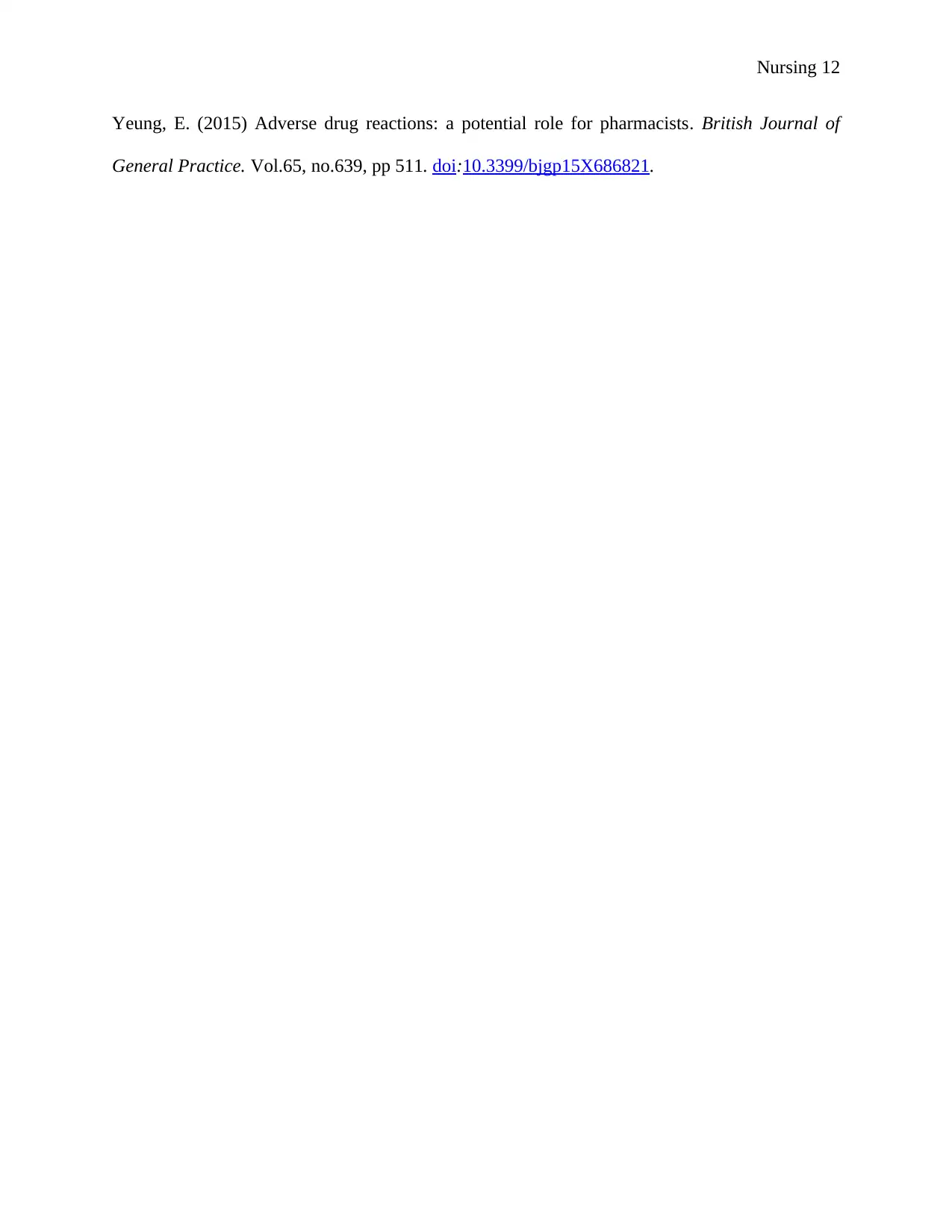
Nursing 12
Yeung, E. (2015) Adverse drug reactions: a potential role for pharmacists. British Journal of
General Practice. Vol.65, no.639, pp 511. doi:10.3399/bjgp15X686821.
Yeung, E. (2015) Adverse drug reactions: a potential role for pharmacists. British Journal of
General Practice. Vol.65, no.639, pp 511. doi:10.3399/bjgp15X686821.
1 out of 12
Related Documents
Your All-in-One AI-Powered Toolkit for Academic Success.
+13062052269
info@desklib.com
Available 24*7 on WhatsApp / Email
![[object Object]](/_next/static/media/star-bottom.7253800d.svg)
Unlock your academic potential
© 2024 | Zucol Services PVT LTD | All rights reserved.





